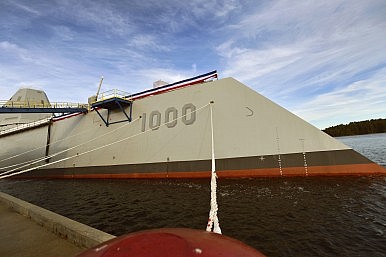
Image Credit: DoD photo by Glenn Fawcett
America’s Newest Destroyer Is Already Outdated
Hie thee hence, sea fighters, to peruse Information Dissemination‘s take on the U.S. Navy’s Zumwalt-class
destroyer. Pseudo-pseudonymous pundit “Lazarus” gives a nifty profile
of the newfangled vessel. That’s worth your time in itself. Though not
in so many words, moreover, he depicts the attention-grabbing DDG-1000
stories of recent weeks and months as a red herring. Sure, Zumwalt features a “tumblehome” hull that makes the ship look like the second coming of USS Monitor. (This is not a compliment.) The hull tapers where it should flare and flares where it should taper. Zounds!
Yet
more than cosmetics occasions commentary. Some navy-watchers voice
concern about tumblehome hulls’ seakeeping ability in rough waters.
Others question their ability to remain buoyant and stable after
suffering mishaps or battle damage. That’s a worry in a “minimum manned”
ship that relies on automated damage control. (The very idea of
automated firefighting and flooding control, and sparsely populated fire
parties, sits poorly with this former fire marshal.) In any event, time
will tell whether the naval architects got it right.
Even if problems do come to light, Zumwalt would be far from the first fighting ship to undergo modifications to remedy problems baked into her design. The flattop USS Midway, for example, underwent repeated change over her long life — including to correct such maladies. Plus ça change.
Zumwalt‘s
secondary armament has made headlines as well. The navy recently opted
to substitute lesser-caliber 30-mm guns for the 57-mm guns originally
envisioned to empower the ship to duel small boats and light surface
combatants. The smaller mount evidently meets performance parameters for
close-in engagements that its bigger counterpart misses. This too is a
controversy that, in all likelihood, will be settled once sea trials put
the ship through her paces. Tempest, meet teapot.
Such
controversies obscure matters that are more elemental and consequential
than hullforms or selecting a secondary gun. The truly important
DDG-1000 question is a question of purpose. Navies exist first and
foremost to win command of the sea, overcoming foes’ efforts to deny it
this goal or exercise command themselves. Zumwalt, by contrast,
is almost exclusively a shore-bombardment platform, designed to rain
projectiles on targets far inland. That means she will either rely on
other ships to hold enemy defenses at bay, or perform her mission under
near-constant enemy fire. The hard fact confronting mariners is that
shore-based defenses — tactical aircraft, anti-ship and anti-air
missiles — now outrange the U.S. Navy fleet, while even lesser navies
boast an array of submarines and patrol craft able to make trouble for
outsiders. Projecting power ashore must await victory in the fight for
command. Delay can cost you.
The
new combatant, then, is in effect a “flotilla” vessel, to borrow Sir
Julian Corbett’s taxonomy of naval fleets. Such ships neither fight for
command of the sea — that mission falls to the battle fleet — nor join
the “cruiser” contingent to police seas largely scoured of enemies. They
do their rather humdrum jobs once others have borne the brunt of
combat. In a sense, consequently, the U.S. Navy’s priciest, sexiest
warships are now auxiliaries rather than capital ships — the ships that,
in Alfred Thayer Mahan’s parlance, dish out and take heavy punishment
in action against enemy main forces.
That
could be a tough sell for taxpayers, who presumably expect their
hard-earned cash to fund platforms that accomplish the navy’s chief
purpose. So the navy leadership has a salesmanship challenge ahead of
it.
Tactical challenges lie ahead as well. How will commanders employ DDG-1000s? The possibilities are few and unattractive. Zumwalt may
become a “high-value unit” like a carrier or amphibious assault ship,
escorted into combat zones by a retinue of picket ships. The escorts can
attempt to fend off attack while DDG-1000 pummels land targets, much as
carrier strike groups close within reach of the air wing while striving
to defend themselves. Or, Zumwalt can await the results of
battle before taking station within reach of her land-attack cruise
missiles or advanced precision gunnery. Or, she can venture
inshore alone, trusting to stealth to mask her presence. Her builders
boast that the cruiser-sized vessel looks like a small craft on
adversaries’ radar sets. Passive measures such as reducing her radar
cross-section will doubtless help.
But
none of these methods appeal. A concentric formation centered on a
high-value unit is bound to attract unwanted attention. Waiting for safe
seas and skies means postponing the main event, namely projecting force
ashore. And relying entirely on stealth — on a big ship’s capacity to
elude detection — is a hazardous business. Once Zumwalt starts
firing guns and missiles, someone’s eventually going to detect her using
what seafarers ruefully call the “Mark I, Mod 0 Eyeball.” Once the ship
is sighted visually, her minimal ability to ward off surface,
subsurface, air, or missile attack could prove fatal.
In
short, DDG-1000 appears to be a man-of-war built for the halycon 1990s,
when no one contested American command of the commons. The good news is
that, with only three ships of the class forthcoming, the navy can
treat Zumwalt as a fleet experiment, learning what works in her
design and what doesn’t, trying out various tactics, and feeding that
insight into future ship classes. In the meantime, upgrading the main
guns for action against enemy surface ships is a must, as is hastening
the development and deployment of new anti-ship cruise missiles. These
are defects we already know about and must act on. If DDG-1000 is a
surface-combat platform, let’s equip her to domore than fire into a continent.
Faster, please.
No comments:
Post a Comment